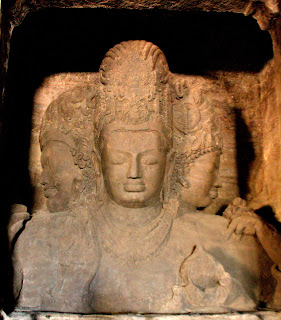I interpret my first journey to India as an astrological pilgrimage that would confirm my cosmic identity as an astrologer through ritual, and expand my knowledge through study with revered masters. It was also a whirlwind introduction to some of the most important temples in India.
I had decided to go to South India first, specifically to request an audience master of Jaimini Astrology, Sri Iranganti Rangacharya in Hyderabad, Andhra Pradesh, do Giri Valam at Arunachala in Tiruvannamalai and to do the yatra of the Nava Graha Temples near Kumbakonam.
There seems to be a pretty ancient, but not well known astrological aspect to the temples and you can even use the chart to find your Ishta Devata or personal Jyotirlinga. You may already know about these techniques. I became a Shiva bhakta, and specifically Jyotirlinga worshiper, during that same journey to the Nava Graha Sthanams.
What brought about my first journey to India was the fact that I didn't like my Solar Return for Thailand, where I was living at the time. I decided to go to India for a month. My birthday would fall within that month. I started in Hyderabad, Andhra Pradesh, as I wanted to have an audience with Smt. Iranganti Rangacharya, one of the leading scholars on Jaimini Astrology. After Hyderabad I was going to start my temple pilgrimage with Srisailam and then move south to Kumbakonam. However, there was a general strike in Andhra so it was suggested that I go to Tamil Nadu first. I wasn't sure where to go, but the maid at the house where I was staying was a virtual encyclopedia regarding temples. She knew all of them! Even the small ones in tiny villages! She was amazing! I had told her that I was interested in Shakti Peethams - I had been to Kalighat already since I had flown into Kolkata. She suggested Kanchipuram, "Many temples, too big, too beautiful....Shakti Peet!" I decided to take her suggestion and took the train to Chennai and a bus to Kanchipuram. My birthday is January 1, and I arrived in Kanchi on the night of the 31st. On the morning of my birthday I received darshan of Sri Kanchi Kamakshi Devi, Sri Varadaraja Perumal and, most importantly Lord Shiva as Ekambareshwarar at Ekambaranathar Temple. Something happened to me on regarding the lingam that I still can't put into words, but an exchange of some sort happened. I then went to Tiruvannamalai. I was looking for temples where I could propitiate Sani to help my 2nd house - Dhanus Lagna, and found information about Arunachala Hill and how it is a manifestation of Lord Shiva. I wanted to do Giri Pradakshina there around the hill and also receive Darshan of Lord Annamailayar. Ekambaranthar and Annamailayar temples were the two most impressive temples that I had ever seen or experienced, and I soon found out that these temples were two of the five Pancha Bhootha Sthanams, where Shiva is worshipped as the five elements. I arrived on the evening of my birthday and had darshan of Lord Shiva. Annamailayar temple is where Lord Shiva is worshiped as fire, and in the garbagraha there is space for about 15 people to sit and revere lord Shiva up close. That little room was intensely hot, like a sauna, and I assure you that there is nothing in that room to heat it except the presence of the Lingam itself. I did Giri Pradakshina around Arunachala the next day and left for Kumbakonam the day after, at which time I embarked on the yatra that about which I have written previously.
From Kumbakonam I went back to Hyderabad, and then to SriSailam, which is one of the 12 Jyotirlinga temples. It is usually placed second on the list of importance, after Somnath in Gujarat. The mystical energy was palpable there, especially at night - I arrived at 2am. I stayed for 3 days and had many darshans. Booklets are always sold telling the myths and legends connected with the temples, and I found myself ruminating on the fact that there were 12 of them. Of course, my next thought, as an astrologer, was "I wonder if they correspond to the Rasis?" Which of course they do.
I have included a listing of the Rasis that correspond to each Jyotirlinga Temple along with the mantra for worship. To worship or propitiate a planet, use the temple that represents the planet's exaltation rasi:
Aries (exaltation of sun) rameshwaram
“om namah shivaya namah rameshwaraya”
Taurus: (exaltation of moon) : somnath
“om namah shivaya namah somnathaya”
Gemeni: (exaltation of rahu) : nageshwar
“om namah shivaya namah nageshwaraya”
Cancer: (exaltation of jupiter) : omkareshwar
“om namah shivaya namah omkareshwaraya”
Leo: ( ) : vaidynath
“om namah shivaya namah vaidyanathaya”
Virgo: (exaltation of mercury) : mallikarjun
“om namah shivaya namah mallikarjunaya”
Libra: (exaltation of Saturn ) : mahakaleshwar
“om namah shivaya namah mahakaleshwaraya”
Scorpio: ( ) : ghashanesha
“om namah shivaya namah ghrashaneshwaraya”
Sagitarius: (exaltation of ketu) : vishwanath
“om namah shivaya namah vishwanathaya”
Capricorn: (exaltation of mars) : bhimshankara
“om namah shivaya namah bhimshankaraya”
Aquarius: ( ) : kedarnath
“om namah shivaya namah kedarnathaya”
Pisces: (exaltation of Venus) : tryambakeshwar
“om namah shivaya namah tryambakeshwaraya”
It turned out that SriSailam represented the sign Virgo, which is my Arudha Lagna and Lord Buddha is my Atmakaraka. Of course, Buddha is exalted in Virgo so it turned out that I was worshiping my own Atma Linga! This began my love/obsession for Lord Shiva and the quest to find and visit my personal Jyotirlinga.
















